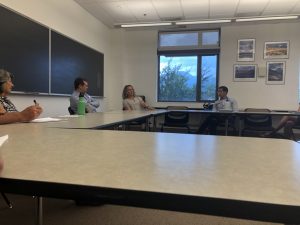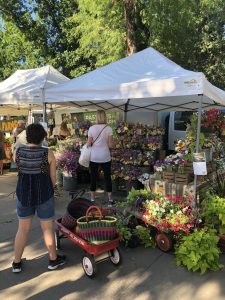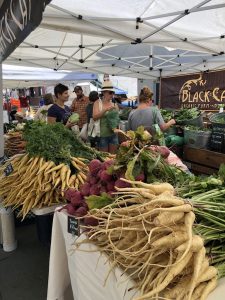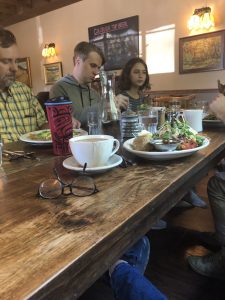The day following our return from the field trip I wrote about in the third installation of this most excellent blog, we were paid a visit by Colorado’s Commissioner of Agriculture, Kate Greenberg. She directs 300 employees at Colorado’s Agriculture Department, so it was a real privilege for her to speak to a class of four of us. Thankfully, Prof Harris invited a number of people from the Colorado Springs community to attend as well, so Greenberg’s visit was a little bit more impactful. It seemed as though the audience valued the opportunity to ask Greenberg a few questions and hear about what she does a lot. It was a rare experience at CC where academia, politics, and community came together in one room. That sort of integration and conversation makes a big difference and I applaud Prof Harris for setting up the meeting. I think CC should make that sort of community engagement more common in its course design and syllabi.
About Kate Greenberg, she was nominated to the position of commissioner this past winter by Governor Polis and she is the first woman to hold the position in the state’s history. Greenberg is a Minnesota native and was a conservationist and farmer in the West before becoming the Western director for the National Young Farmers Coalition. There she worked on moving legislation through Congress that removes barriers for young people to get into farming and secures a decent future for agriculture in this country. Greenberg is in her early thirties, confident, and outspoken. That is good because after hearing a little about all of us in the room, she gave us the inside scoop of what the Colorado Department of Agriculture is up to at the moment. The Department is tasked with doing a lot of kind of frivolous things such as taring all of the scales that exist for commercial or official use in the state. After all of these bureaucratic, administrative, and minor duties are taken care of, Greenberg estimated about 10% of total bandwidth remains for what she considers the really meaningful projects. This includes rural mental healthcare, cannabis agriculture and market development, farm succession, organic certification capacity, water access and conservation, sustainable agriculture, market diversification, and of course supporting the next generation of farmers. She explained that the most valuable tool she has is listening. That is the most important part of her job. You have to listen to the needs of actual people, she said. Positive change is impossible if politicians and academics force producers and distributors to fit into a particular plan of theirs that is decoupled from their operations and experience. I asked Commissioner Greenberg about probably the biggest problem facing farmers in Colorado and across the country, and she responded by lamenting the fact that her department has no control over the matter. It is a federal issue and something that local politics just cannot fix. It is amazing to me that agriculture and construction and the like, the basis of our economy, infrastructure, and food supply is so often left out of the conversation on immigration. Mechanization can solve for industrial agriculture and CAFOS operations to a degree, but it takes a lot of hard work to grow real food and it turns out that seven out of ten farmworkers in the USA were born in Mexico. Farmers have raised wages for years across the country, despite being squeezed from all sides, but still rely almost entirely on immigrant labor and the H2A work visa program. The latter is a strictly seasonal program, though, so it does not help producers who have year-round operations very much. Plus, small and midsized farmers do not have the time nor the administrative staff to handle the stack of paperwork. So rural America really needs immigration. The disconnect amazes me. Anyways, it was great to have a conversation with Commissioner Greenberg and I hope it was worthwhile for her.

On Friday we discussed environmental regulation and farming and how policy shapes agricultural operations and supply chains.
I mentioned in a previous blogpost that we were each asked to write a farmers market response for the class. I drove up to Boulder and swung by the Boulder County Farmers Market’s (BCFM) Boulder Farmers Market on Saturday morning. I am just going to insert an excerpt from my response here. Please skim over it if you don’t have much care for the yuppiness of Boulder or if farmers markets are old news. But here it is regardless,
“BCFM is truly an institution. I have been lots of times in the past, but it doesn’t really get old. It helps that it is in a beautiful park that is landscaped perfectly. Boulder is also very walkable and lots of people walk over, hang out in the park, and have a good time. There are dozens of vendors, some crafts, and then artisanal food products and the freshest of produce. The first thing I found was a long line for the favorite cherry grower. Then there were two biodynamic farms with displays and a couple of other vegetable farms. It is one of those experiences where you pick some amazingly colored greens out of the basket they have on display, take a nibble, and realize that you have been missing out on true complexity of flavor (and nutrition). There’s herby salad greens in the tub at the grocery store and then there are salad greens. The varieties of alliums, summer squashes, brassicas, beans, peas, root veggies, tree fruit, and the bounty of herbs are just phenomenal. There are also ranchers who sell heritage breed beef and pork and lamb and buffalo with all of the cuts. Multiple people sell some cool looking eggs. There’s an artisanal baker, a coffee roaster, a pastry stand, kombucha, kvass, spring water, wine, knife sharpening, all the things. There is a mushroom crew that sells a good dozen different types of mushrooms. I spoke to the guy who made the Boulder Tortillas that use indigenous blue corn to make the tastiest of chips and tortillas. He had something new for me: he cooked up some blue corn gorditas in goat’s butter and had me spread on some of his garlic dip. Totally delicious. I spoke to one of the heritage breed cattle farmers which was fun. The farmers I bought apricots and cherries from wake up at 2am every Saturday to drive from the Western Slope and set up at the market. Sort of nuts. They looked tired, but their fruit was delicious. There are flower vendors and hot sauce companies and more. I spoke to the guy who started Fortuna Chocolate—really freaking good chocolate—and he’s a true artist. I have had lots of fine chocolate in the past and even grown and processed some in Peru, and Fortuna occupies a high place in the chocolate stratosphere. He is from Mexico d.f. and has perfected the technique of bringing out the chocolate essence using correct ratios, spicing, and quality cacao. There are also a bunch of food stands for breakfast and lunch. The whole market is zero-waste (kind of). Everything at the market has to be compostable (mostly) or recyclable (a few things). The market is teaming with activity. There are a bunch of families and kids, lots of couples, friend groups, loners like me, students, old people, working professionals, outdoorsy people, yogis, hippies, artsy types, business types, and tourists. People are relaxed, smiling, and so forth. It is a diverse bunch, or it feels that way compared with Colorado Springs. They do an excellent job at cultivating community, in part because it is just such a fun and amazing event to visit, the displays are nice, and there are samples. Most things are also not that expensive. Anyways, it shows that if people have money, leisure time, if there are nice progressive restaurants that care about the quality of their produce, and there is a really good organization, a local and sustainable food system can be cultivated. I mean, Boulder County preserved a lot of its farm land and kept it from developing and there is a very strong market for good, local, fresh and artisanal food. Boulder likes to support its producers and people in Boulder appreciate effort, creativity, and hard work. That seems not to be the case in Colorado Springs. But so all of these pieces have to align to support a local and sustainable food system. And personally, I think that starts with wealth and prosperity, education, and diversity”.


On Monday, the class took a trip to Adams Mountain Cafe on the eastern edge of Manitou Springs to use up our field trip funds and speak with Dave. He is the chef and has owned and managed the institution for the past twenty years. He is a great guy and has a good story. Adams Mountain is really the only full-service restaurant in the Springs area that has made a big effort of serving a healthy menu using sustainable and locally-sourced ingredients. The food is quite tasty, reasonably priced, and they have a large fanbase. They’ve got a nice place too, all rustic wood chairs, long tables, cool art, and swanky bar. It is not easy to source locally in the Springs, due to the lack of many producers and a robust distribution network. He has to place orders for his restaurant alone, often times. He says it is worth it, though, because the produce is that much fresher and more flavorful. We talked about the trials and tribulations of running a restaurant and owning a property in that particular location and dealing with the neighbors. He also told us about the unique customer base Adams has and the type of people who love his food, the man who has ordered the huevos rancheros every visit for twenty years, and the type of people who come in, sit down, take a look at the menu, get up and leave. We did have class before lunch, by the way.

The class showed up early on Tuesday morning to tune into a House subcommittee hearing on Agriculture on C-SPAN. Present as witnesses were representatives from each of the sectors of animal Big Ag: cattle, turkey, lamb, egg, and pork producers organizations. I liked how each of them had a metal figure of their respective animal pinned on their lapels. The common sentiment among all of them was twofold: they requested that the government implements more safety measures to prevent outbreaks in their CAFOS factories, and that they really need the government to figure out labor. All of them had had some devastating disease outbreak in the last few years and all of them were experiencing a scarcity of labor. The China trade war also came up, especially from the pork guy. I wouldn’t call it an enlightening hearing per se, but it was interesting that all of these conventional meat organizations only exist because of government subsidies–for them and for the feed they buy–and bailouts, and yet they still are requesting more assistance from the government to cover the cost of outbreaks or enforce strict regulation to prevent them from happening. The egg producer even blamed backyard chicken keepers near his factory in California for both accidentally and intentionally inoculating his chickens with disease. After that diatribe and complaining session, the class learned about pollution, toxicity, outbreaks, and the food system.

On Wednesday, each of we students gave a presentation about our individual research papers. Prof Harris invited a couple of people from COS to attend, just to raise the stakes a bit. Unfortunately, Andrew had a family emergency and could not be present. But Hope presented about the role of carbon farming in a potential carbon market. The carbon sequestration potential in soils is quite substantial and farmers should receive offsets in a cap-and-trade system and farmers should receive tax credits in a carbon tax scenario. So any holistic carbon market economy should factor in farming, its emissions, and its potential for carbon sequestration. Ian shared about how Monsanto (Bayer) is ‘the enemy of all things good and righteous’. They sell a product that kills soils, poisons people, and does not actually increase yields. The company has monopolized the seed industry by bullishly patenting seeds and actively persecuting seed saving. Their company policies make farmers beholden to their engineered seed and makes sure that farmers do not stray from their mechanical apparatus. They have produced a lot of fake science over the years and they have lobbied very hard. The history of Monsanto is kind of fascinating and absolutely infuriating. But yes, Ian came to a convincing conclusion about Monsanto’s (Bayer’s) value for society. I was last to present. I originally set out to compile an ideal policy package that incentivizes farmers to adopt regenerative agriculture and begin carbon farming. But I soon came to the realization that those specific policy ideas, and efforts by private investors and NGOs, will not add up to any major change in our food system and will not sufficiently make a dent in climate change mitigation. So instead, I took up the challenge of writing a Green New Deal that centrally focuses on agriculture and rural America and takes a systems-thinking approach to fixing the food system. After a lot of writing this week, I will again just paste an excerpt from the conclusion of my paper, which didn’t exactly spiral out of control, but did end up stretching to twice the suggested page limit:
“In review, I assert that meaningful climate action will only take place if the United States leads the way. The best way for the country to decarbonize its economy is to improve the food system by investing in carbon farming. Carbon farming must be the basis of our economy and supporting it will revitalize rural America. To accomplish this, the healthcare and education costs of all Americans has to be covered and the median American has to earn more money. More money and more education will result in an increased budget for food. With this and the help of market mechanisms, infrastructure development, and targeted incentives by the government, the diets of Americans will improve dramatically as will their health, and the countryside will act as a carbon sink. This necessarily means the end of big agribusiness and big food as we know it. The government has to restrict suburban development, improve our urban infrastructure and transportation networks, and invest heavily in rural America. Farmland should not compete with suburban sprawl and solar farms. Any amount of farmland that is taken out of production due to more intensified agriculture should be set aside as conservation easements which sequester carbon and increase biodiversity. The government has to provide a streamlined, expedited pathway to citizenship for immigrants because the future of our economy hinges on a productive labor force. A national composting program should be set into motion. Aquaculture should be expanded. Cows must be fed seaweed to decrease their methane emissions. Annual crop production acreage should be decreased, transformed using ecological agriculture, and replaced by perennial and agroforestry systems. Pasture should be managed using intensive ruminant grazing. This paper has been a response to the Green New Deal and a response to the ineffectuality of small changes to promote better farming practices and carbon reduction efforts”.
Yep, so in addition to our research papers, we were also assigned a final exam essay which required a lot of fleshing out in order to answer properly. The prompt was essentially to argue wether scientific ‘wizardry’ or the teachings of a traditional ‘prophet’, as relating to our course’s textbook The Wizard and the Prophet by Charles C. Mann, is the answer to feeding 10 billion people. Borlaug is the wizard in his book who begins the Green Revolution and Vogt is the prophet who predicts a carrying capacity of the Earth and advocates for conservation and population control. I do not know exactly how my comrades in education responded to this essay, but I conclude that we need a more nuanced approach to the future of agriculture than just laboratory technology and synthetic inputs versus traditional farming. Instead, our entire political-economy has to be examined and we need to improve our agricultural systems by using science and technology in an ecological way to improve efficiency and intensify regeneration.
That’s it. Unfortunately the EV department is letting go of Prof Harris and this was likely his last class, so I cannot advocate that you should take the class because it will no longer exist. But I am very glad that I had the opportunity to take it.
Congratulations! You are one of the very, very few people to read this blog. Hope you liked it. I was asked to write this blog at the last minute and I guess it contributed to my learning? It certainly took a significant investment of time. The Communications Department, Summer Session, and the College has yet to share it or anything, so really nobody read it, but hey, you did!